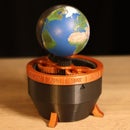Introduction: Astronomy Intervalometer
One of my hobbies is Astrophotography.
Astrophotography is different from common photography, when you take a picture trough a telescope , because galaxies and nebulae are dark, you must take a long exposure photography (30s to several minutes) and increase ISO (800 to 6400) but with such settings, the photography will have flaws (noise, vignetting, …)
A solution is to reduce them is photoshop, but there is a problem : by reducing flaws, the signal will also be reduce.
To fix that, there is a method called "Stacking", we take a lot of pictures of the same object (those are called "lights"). By overlaying those lights, we can increase the signal/flaws ratio, so we now can edit it in a photography software like photoshop, lightroom or The Gimp.
To improve the ratio even more, we can take "DOF" and use them in pre-processing, DOF are three kinds of pictures (Dark, Offset and Flat) we need at least 40 of each.
Each DOF fixes a specific flaw:
Dark : fixes sensor’s noise due to long exposure (this noise depends on temperature)
Offset : fixes sensor’s noise (this noise is specific to each sensor)
Flat : fixes vignetting
So in order to take long exposure pictures automatically, I built an intervalometer:
I want it to take photos on my reflex camera of X seconds of eposure with 2 seconds between each.
Supplies
- 1x Arduino nano
- 1x 4 digits 7segment display
- 1x rotary encoder + knob
- 1x push button
- 1x 5V relay
- 1x 47µF capacitor
- 4x 1k resistors
- 1x 10k resistor
- 1x 2.5mm audio Jack + ~15cm wire
- Wires
- External battery + cable to power the arduino
Tools:
- Soldering iron
- 3D printer
- Breadboard + jumper wires (prototype)
Step 1: PROTOTYPING
If you make this instructables be sure your reflex has a "BULB" mode and a 2.5mm jack plug for a remote.
When rings A and B are connected, the camera take a photo, in my circuit the connection is made by the relay.
I used a breadboard to test the circuit and the code, everything worked just fine (the blue LED represents the relay)
Attachments
Step 2: BOX + ASSEMBLY
I made a 3D printed box using fusion 360, printed with the creality ender 3.
If you don’t have access to a 3D printer you can drill holes in a plastic project box or even make a box out of wood.
All components fit snugly in the box, so avoid using too long cables in the circuit.
I printed another part in order to place the intervalometer on the canon hot shoe.
When the assembly is done you can glue the cover on the box and the hot shoe adapter under the box.
Step 3: HOW TO USE IT
- Prepare the telescope and place the camera on it
- Place the intervalometer on the camera
- Plug the 2.5mm jack
- Set the camera on BULB mode
- Power the intervalometer (a "5" appears)
- Turn the encoder to set the exposure time
- Press the encoder to start shooting
- Let several hours
- Press the reset button to stop shooting
NB : you sould be able to make it shot time lapses by inverting HIGH and LOW of the « relais » in the loop part of the code. That way you will set the time between each picture.
Step 4: RESULTS
here are two months of Astrophotography with the intervalometer
- M81 & M82
- M33
- M31
- M27
- M52 & NGC7635
The telescope is a 150/750 by Skywatcher and the camera is a Canon 750D

Participated in the
Multi-Discipline Contest











![Tim's Mechanical Spider Leg [LU9685-20CU]](https://content.instructables.com/FFB/5R4I/LVKZ6G6R/FFB5R4ILVKZ6G6R.png?auto=webp&crop=1.2%3A1&frame=1&width=306)





